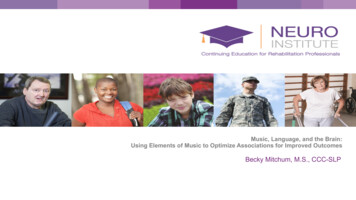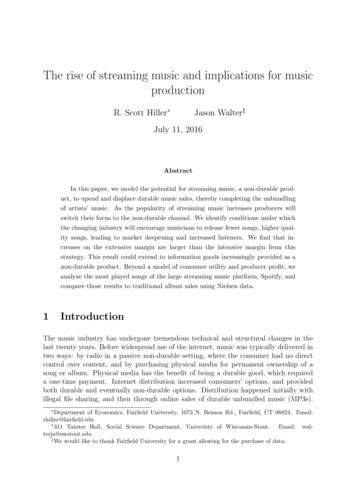
Transcription
Music, Language, and the Brain:Using Elements of Music to Optimize Associations for Improved OutcomesBecky Mitchum, M.S., CCC-SLP
IntroductionBecky Mitchum is a certified speech-language pathologist on the pediatric team at NeuroRestorative Timber RidgeRanch, a post-acute inpatient rehabilitation facility on 315 wooded acres in Benton, Arkansas. She is a member of theAmerican Speech-Language Hearing Association and the American Hippotherapy Association.She comes to speech-language pathology from nearly three decades as a professional violinist, performing as well asteaching the Suzuki method to children as young as three. Being an “old new” speech-language pathologist with thisbackground gives her passion and curiosity to use music or aspects of music in speech and language therapy wheneverit is appropriate."Logic will get youfrom A to B.Curiosity and imaginationwill take you much farther.“-attributed to Albert Einstein-
Music, Language, and the Brain:Using Elements of Music to Optimize Associations for Improved OutcomesPURPOSE of PRESENTATION:To inform participants of how incorporating elements of music can buildassociations in the brain for improved outcomes through multi-modal learning.KNOWLEDGE: Participants will be able to list at least three ways elements of musiccan stimulate associations in the brain.COMPREHENSION: Participants will be able to summarize at least three benefits toincreasing associations in the brain.APPLICATION: Participants will be able to apply at least one new musical element ina current professional health care context.
Contents ForBusy People:Eight 5-MinuteBullet Points1.2.3.4.5.6.7.8.A Venn Diagram of Six Health Care DisciplinesWhat is the Difference Between a Music Therapist and AnyOther Health Care Professional Using Music in Therapy?Music and Language as “Dual Hemisphere Processes”Neuroplasticity, Albert Einstein, and Chocolate Chip CookiesEBP: Getting to Know Some Neuroscientistsand What They Say About MusicWho Cares About the Science, Give Me the Tricks: FourWays to Use Elements of Music to Optimize Associations forImproved OutcomesThree Ways Elements of Music Can Be Useful in TherapiesNot Associated With MusicTreasures for Future Reference
COGNITIONMental processes and their products.
Music, Language, and the Brain:Using Elements of Music to Optimize Associations for Improved Outcomes1A Venn Diagram of 6 Sets of Health Care Disciplines Speech-Language Pathology Occupational Therapy Physical TherapyCOGNITION Behavior/Counseling Nursing Music Therapy
Music, Language, and the Brain:Effective Interventions Using Elements of Music2What’s the Difference Between a Music Therapist andAny Other Health Care Professional Who Uses Music in Treatment?MUSIC THERAPY is an accredited health care profession using the systematicapplication of music in the treatment of cognitive, social, communicative,behavioral, psychological, sensor-motor, and physical needs of clients.Entry level degree to be a practicing music therapist is a bachelor’s degreefrom an accredited college/university. Credentials are obtained by graduating,completing an approved internship, and passing a board certification exam.There are masters level and doctoral level degrees in music therapy for thosewishing to pursue higher education in music therapy.
Music, Language, and the Brain:Using Elements of Music to Optimize Associations for Improved OutcomesSIMILARITIES BETWEEN MUSIC and LANGUAGEand WHAT I MEAN BY ‘ELEMENTS of MUSIC’ Music and language are universal, unique to each culture. Both have pitch, timbre, rhythm, durational features, require perception, areexpressed with varying rates of speed, can change meaning depending on volume,and both have rule-governed written symbol systems. ‘Elements of Music’ in this presentation refer to the use of pitch, rhythm, tempo,volume, and perception, but not to the written symbol system of music. Spontaneous speech and spontaneous singing typically develop in children atapproximately the same time Both the expression of music and the expression of language are acquiredhierarchically.
Music, Language, and the Brain:Using Elements of Music to Optimize Associations for Improved Outcomes3Music and Language as Dual Hemisphere ProcessesThe left side of the brainlargely governs logic,mathematics, rotelearning, therules of musicand also therules of language,and the symbolsystems forboth.The right side of the brain largelygoverns creative and intuitivethinking. The right side isusually dominant for facialexpression, melodicexpression andpossibly the ability tocalibrate volume to matchthe social situation orthe content of the music.
Music, Language, and the Brain:Using Elements of Music to Optimize Associations for Improved Outcomes4Neuroplasticity, Albert Einstein, andChocolate Chip CookiesTerminology Refresher-NEURONS-GLIAL CELLS-NEUROPLASTICITY
When is it not appropriate touse elements of music?Not every element of music willbe appropriatefor every oyalty-prefers-the-trumpet-to-the-trombone/
Music, Language, and the Brain:Using Elements of Music to Optimize Associations for Improved Outcomes5EBP: Four Neuroscientists and What They Say About Music(or: Don’t Just Take My Word for It)“Actively participating in music exercises parts of the brain that are shared in language processing.” – Dr.Ani Patel“Music activates older parts of the brain, implying we’ve had music in our evolutionary past even beforelanguage.” – Dr. Daniel Levitin“ My research looks at how the brain processes musical elements which require attention, memory,executive function, language, motor control -- and asks the question: are there mechanisms in musicwhich can be transferred to non-musical functions? And the answer is yes, there are.”-- Dr. MichaelThaut“Music is a strong stimulus. It is a multi-sensory, multi-modal experience. Because it is multi-modal, musichelps us develop or engage more associations in the brain.” – Dr. Gottfried Schlaug
Videos of FourNeuroscientistsDiscussing Musicand the Brain1. (a) Dr. Ani Patel: Music Training and the Brainhttps://youtu.be/z5cHrUMzNww(b) Dr. Ani Patel: The Music of Language and the Language of Musichttps://youtu.be/2oMvtw4aeEY2. Dr. Daniel Levitin: Music and the Brain – the World in Six Songshttps://youtu.be/2oMvtw4aeEY3. Dr. Micahel Thaut: Rhythm and Music for Motor Control . Dr. Gottfried Schlaug: From Singing to Speaking,Examples from Aphasia and Autismhttps://youtu.be/8yMO0FmNyS8
Music, Language, and the Brain:Using Elements of Music to Optimize Associations for Improved Outcomes6Who Cares About the Science, Give Me the Tricks:Four Ways to Use Elements of Music for Improved OutcomesA. MELODIC INTONATION THERAPY (MIT)q uses rhythm, pitch, and touchB.NEUROLOGIC MUSIC THERAPY (NMT)q uses primarily rhythm and tempoC. NEURODEVELOPMENTAL TREATMENT (NDT)& USING A BREATHER TRAINER with a BUHL SPIROMETERq uses posture, alignment, lung capacity, and coordinated breathingD. RHYMES and SONGSq uses rhythm and tempo
Music, Language, and the Brain:Using Elements of Music to Optimize Associations for Improved Outcomes6Who Cares About the Science, Give Me the Tricks:Using Elements of Music (continued)The Breather TrainerThe Buhl Spirometer
Music, Language, and the Brain:Using Elements of Music to Optimize Associations for Improved Outcomes7A.B.C.D.D.How to Use Elements of Music toOptimize Associations for Improved OutcomesMelodic Intonation Therapy can help with expressive language disorders and with fluency disorders –typically the domain of speech-language pathology, but anyone can use its principles to help a personspeak more deliberately.Neurologic Music Therapy can help with acquiring any skill that needs to be broken down to its simplestform and practiced systematically while incorporating motor movement – typically the domain of physicaltherapy and occupational therapy, but applicable to any discipline involving muscle memory.Neurodevelopmental Treatment & Using a Breather Trainer and Buhl Spirometer can help someone speakwith better volume, clarity, and prosody – typically the domain of physical therapy, speech-languagepathology, or of singing instruction, but anyone can use this who understands posture and alignment.Rhymes & Songs can help model correct rhythms of our language, help build phonological awareness (acrucial reading readiness skill), teach figures of speech, learn sequences of events, and serve as mnemonicdevices for memory – typically the domain of speech-language pathology and of good parenting, butobviously anyone can use these.Playing music to distressed clients can reduce anxiety and depression – typically the domain of socialworkers/mental health therapists, but applicable to everyone.
Music, Language, and the Brain:Using Elements of Music to Optimize Associations for Improved Outcomes8Videos, Websites, and Books: Treasures for Future /youtu.be/H-FgDIfd1Xs (rhythmic les/assets/Sites/Longwood ck.pdf (Music As Medicine: The Impact of Healing Harmonies, Gottfried -author-your-brain-music: From Musician toNeuroscientist, An Interview with Daniel LevitinMusicophilia: Tales of Music and the Brain, Revised and Expanded Edition Paperback – September 23, 2008 by Oliver SacksThis Is Your Brain on Music: The Science of a Human Obsession, Paperback – 2013 by Daniel LevitinMusic, Language, and the Brain, Paperback – 2010 by Aniruddh Patel
REFERENCESBégel, V., DiLoreto, I., Seilles, Al, Dalla Bella, S. (2017). Music games: Potential application and considerations for rhythmic training.Frontiers in Human Neuroscience, 11, 273.Bradley, J. (Spring 2005). When to twinkle – are children ever too young? American Suzuki Journal (33), 53.Brown, S., Martinez, M., Parsons, L. (2006). Music and language side by side in the brain: A PET study of the generation of melodies andsentences". European Journal of Neuroscience. 23 (10), 2791–803.Buhusi, C., Meck, W. (2005). What makes us tick? Functional and neural mechanisms of interval timing. Nature Reviews Neuroscience.6, 755–765.Dingle, G. (2012). To be heard: The social and mental health benefits of choir singing for disadvantaged adults. Psychology ofMusic. 41 (4),405–421.Janata, P.; Grafton, S. (2003). Swinging in the brain: shared neural substrates for behaviors related to sequencing and music. NatureNeuroscience.6, 682–687.Jentschke, S., Koelsch, S., Sallat, S., Friederici, A. (2008). Children with specific language impairment also show impairment of musicsyntacticProcessing. Journal of Cognitive Neuroscience. 20 (11), 1940–1951.
REFERENCES (continued)Lewis, P. A.; Miall, R. C. (2003). Distinct systems for automatic and cognitively controlled time measurement: evidence fromneuroimaging. CurrentOpinion in Neurobiology. 13, 250–255.Lucero, J. (1995). The minimum lung pressure to sustain vocal fold oscillation. The Journal of the Acoustical Society of America. 98 (2),779–784.McIntosh, G. C.; Brown, S. H.; Rice, R. R.; Thaut, M. H. (1997). Rhythmic auditory-motor facilitation of gait patterns in patients withParkinson’sdisease. Journal of Neurology, Neurosurgery & Psychiatry. 62, 22-26.Norman-Haigmere, S., Kanwisher, N., McDermott, J. (2016). Distinct cortical pathways for music and speech revealed by hypothesis-freevoxeldecomposition. Neuron. 88(6), 1281–1296.Norton, A., Zipse, L., Marchina, S., Schlaug, G. (2009). Melodic intonation therapy: shared insights on how it is done and why it mighthelp.Annals of the New York Academy of Science. 1169, 431-436.
REFERNCES (continued)Loui, P., Wan, C., Schlaug, G. (July 2010). Neurological bases of musical disorders and their implications for strokerecovery. Acoustics Today. 6 (3).Tabei, K., Satoh, M., Nakano, C., Ito, A., Shimoji, Y., Kida, H., Sakuma, H., Tomimoto, H. (2016). Improved neuralprocessing efficiency in a chronic aphasia patient following melodic intonation therapy: Aneuropsychological and functional MRI study. Frontiers in Neurology. 7, 148.Thaut, M. H.; McIntosh, G. C.; Rice, R. R. (1997). Rhythmic facilitation of gait training in hemiparetic strokerehabilitation". Journal of the Neurological Sciences. 151, 207–212.Verga, L., Bigand, E., Kotz, S. (2015). Play along: Effects of music and social interaction on word learning.Frontiers in Psychology. 6, 1316.
To contact Becky Mitchum:Becky.Mitchum@NeuroRestorative.com
Neuroscientist, An Interview with Daniel Levitin Musicophilia: Tales of Music and the Brain, Revised and Expanded EditionPaperback–September 23, 2008 by Oliver Sacks This Is Your Brain on Music: The Science of a Human Obsession,Paperback–2013 by Daniel Levitin Music, Language, and the










